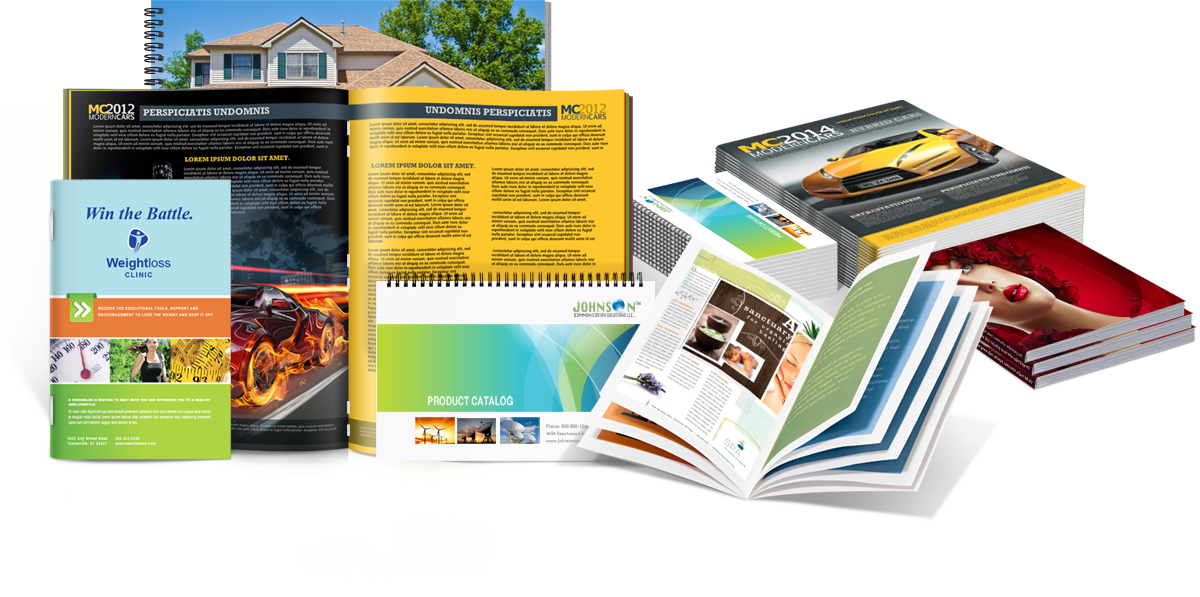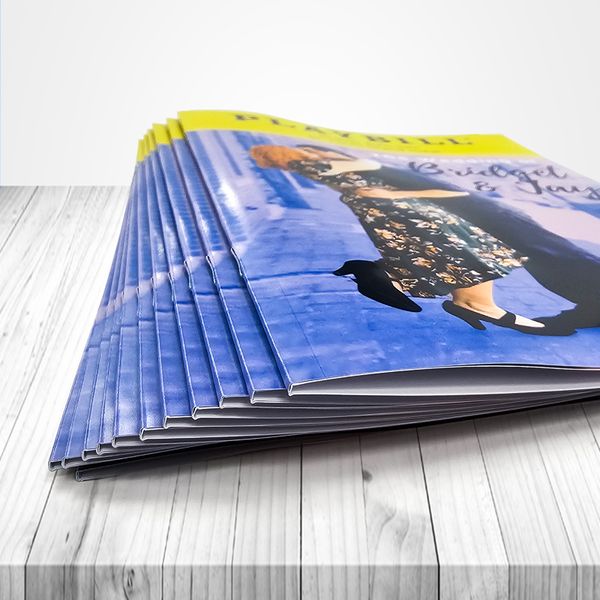Booklet Printing FAQs: Everything You Need to Know Before You Order
Booklet Printing FAQs: Everything You Need to Know Before You Order
Blog Article
The Essential Overview to Understanding Brochure Printing Options and Techniques
The procedure of brochure printing involves several considerations that can substantially affect the last product. From selecting the ideal layout and dimension to understanding the subtleties of binding methods, each option plays an essential duty. Furthermore, elements such as paper supply and printing methods more influence the performance of the brochure. As one navigates these alternatives, it comes to be essential to comprehend how they interconnect and what that implies for the overall result.
Recognizing Brochure Sizes and styles
When taking into consideration booklet printing, understanding the various layouts and sizes available is crucial for achieving the wanted discussion. Pamphlets can be generated in countless styles, including saddle-stitched, spiral-bound, and perfect-bound, each offering unique advantages. Usual sizes range from common letter (8.5 x 11 inches) to smaller sized options like A5 (5.8 x 8.3 inches), permitting for flexibility based upon web content and target audience.Selecting the ideal dimension can influence both the layout and visitor engagement. Larger dimensions could suit visually driven web content, while smaller formats might be a lot more easy to use and portable. Additionally, the variety of pages influences the option of binding technique, as thicker brochures might call for tougher bindings. Ultimately, comprehending these facets permits for a more customized approach, making certain that the last product straightens with the designated message and visual, boosting the overall efficiency of the communication.
Choosing the Right Paper Stock

Binding Techniques: Factors To Consider and options
When it comes to binding methods for pamphlets, a number of alternatives are offered, each with distinct benefits. Saddle stitch binding uses an economical remedy for thinner pamphlets, while best binding methods provide an even more polished try to find thicker publications. Wire-O binding stands apart for its durability and ease of usage, making it optimal for papers that call for adaptability.
Saddle Stitch Binding
Saddle stitch binding supplies a economical and practical solution for assembling brochures, making it a popular choice amongst businesses and publishers. This binding technique entails folding sheets of paper in half and stapling them along the fold line, creating a orderly and neat look. Typically suitable for brochures with a reduced page count, saddle sewing is suitable for publications, pamphlets, and educational products. The simplicity of this strategy permits fast production and is typically preferred for brief runs or advertising items. However, it is vital to note that saddle stitch binding may not be appropriate for thicker brochures, as the back may not hold up under enhanced weight. In general, it continues to be a reputable alternative for numerous printing projects.
Perfect Binding Methods
Perfect binding is an extensively made use of method that gives a specialist and refined coating to pamphlets and publications. This method involves gluing the web pages together at the spine making use of a strong adhesive, permitting a clean edge and the capability to hold a bigger variety of pages contrasted to saddle stitching. Perfect binding is especially appropriate for thicker pamphlets, such as brochures and yearly reports, where a durable, flat spinal column is desired. Additionally, it offers the alternative for a published cover that can be designed to enhance aesthetic charm. Considerations such as web page matter, paper weight, and the meant use of the booklet must be taken right into account, as they can influence durability and total quality.
Wire-O Binding Options
Wire-O binding, known for its durability and adaptability, provides an excellent option for pamphlets that call for very easy page transforming and an expert appearance. This binding approach uses a series of metal loopholes that hold pages safely, enabling them to exist level when open. It is particularly suitable for brochures, guidebooks, and presentations as a result of its durable nature. Wire-O binding is readily available in different shades and diameters, suiting different web page matters and thicknesses. Additionally, it allows the addition of covers and tabs, improving the booklet's general aesthetic. Considerations for Wire-O binding include the choice of cord color, the size of the loops, and the degree of personalization preferred, every one of which can profoundly influence the last product's look and performance.
Digital vs. Offset Printing: Which Is Best for You?
When selecting a printing method for booklets, comprehending the differences in between electronic and balance out printing is important. Digital printing makes use of modern technology to produce top quality prints promptly and economically, making it ideal for short runs or jobs requiring fast turnaround times. It enables modification, giving the capability to print on-demand with very little waste.In contrast, offset printing is a conventional method that masters producing big amounts with constant top quality. It entails moving ink from a plate to a rubber blanket, then to the paper, which leads to lively shades and exact information. However, balance out printing usually needs longer setup times and is extra economical for bigger volumes.Ultimately, the option between electronic and counter printing depends upon project needs, budget, and preferred amount. For little, time-sensitive tasks, digital could be the best choice, while balanced out might be more effective for larger, premium manufacturings.

Creating Your Pamphlet: Tips and Finest Practices
When designing a booklet, careful focus to design, font style choice, and color use can substantially boost its effectiveness. A well-structured layout guides the viewers's eye, while suitable font styles guarantee readability and communicate the preferred tone. Furthermore, efficient use resource color can evoke emotions and emphasize vital info, making the overall design more impactful.
Selecting the Right Layout
Exactly how can one properly choose the right design for a brochure? First, it is vital to review the pamphlet's function and target market. A clean, arranged design boosts readability and involvement. Utilizing a grid system can help in aligning elements regularly, creating an expert appearance. In addition, integrating visual pecking order through differing sizes and placements of photos and message can assist the viewers's eye and emphasize key info. It is likewise important to leave enough white room, which prevents overcrowding and permits much better focus. Examining various formats via mock-ups can give understanding into just how the style executes in real-world circumstances, guaranteeing that the final item satisfies both practical and visual requirements.
Choosing Suitable Typefaces
An appropriate typeface can greatly boost the general design of a pamphlet, matching the design and reinforcing the content's message. The option of fonts need to think about readability, particularly for body message, as it guarantees the details comes to all visitors. Sans-serif font styles are commonly chosen for digital styles, while serif typefaces can offer a standard feel in published materials. It's suggested to limit font choices to 2 or 3 to keep aesthetic coherence. In addition, font style size plays an essential function; headings ought to be unique yet not overwhelming, while body text must fit for reading. When choosing typefaces, alignment with the booklet's style and target audience is necessary for effective interaction and visual appeal.
Reliable Use of Color
Shade works as an effective device in pamphlet style, shaping perceptions and leading reader feelings. It can stimulate sensations of count on, calmness, or enjoyment, depending on the shades picked. Developers need to take into consideration color concept principles, making certain that the selected scheme lines up with the pamphlet's message and target audience. For example, utilizing warm shades like red and orange can create urgency, while cooler tones like green and blue foster tranquility.Additionally, comparison plays an important function; corresponding shades can boost readability and visual allure. Uniformity in color use throughout pages even more enhances brand identification and cohesion. Inevitably, effective shade implementation not only catches attention but likewise strengthens the brochure's function, making it a vital aspect of effective style.
Finishing Touches: Coatings and Unique Effects
While lots of consider the content and layout of a pamphlet one of the most essential elements, the finishing touches, such as layers and unique effects, play a crucial duty in enhancing its general allure. Coatings can supply protection and durability, guaranteeing that the booklet stands up to damage. Matte finishes supply a sophisticated, non-reflective surface area, while glossy coverings can make shades appear even more vivid and captivating. Special effects, like embossing or foil marking, include a tactile measurement that can develop a memorable perception. These strategies can highlight particular locations, drawing interest to vital information or producing visual rate of interest. Furthermore, UV covering can provide a high-shine surface that elevates the general look.Together, these finishing touches not just boost the booklet's aesthetic yet additionally interact professionalism and attention to information, eventually leaving a lasting effect on the viewers.
Cost Factors To Consider for Booklet Printing
Recognizing the various price factors to consider for brochure printing is important for businesses and organizations intending to optimize their budgets. Secret elements affecting costs consist of the choice of ink, paper, and binding techniques. Better products, such as superior paper or specialized inks, typically enhance the total expenditure. Furthermore, the size and web page count of the booklet play a considerable duty; bigger booklets require more sources and time to produce.Another crucial factor to consider is the printing method, whether electronic or offset, as each has its own rates framework and look what i found suitability for various amounts. Organizations must additionally consider design prices, which can vary based on complexity and using expert services. Inevitably, delivery and handling costs can include in the total, particularly for large orders. By reviewing these aspects, companies can make educated choices that line up with their economic capabilities while accomplishing the preferred quality in their published products.
Frequently Asked Questions
What Are the Environmental Effects of Pamphlet Printing?
The ecological impacts of brochure printing consist of logging from paper production, carbon exhausts from transportation, and waste generation from disposed of materials - Booklet Printing. Sustainable techniques, such as making use of recycled paper and green inks, can reduce these results
Exactly How Can I Ensure Color Accuracy in My Brochure?
To assure color accuracy in a brochure, one must use adjusted displays, utilize expert color accounts, conduct test prints, and choose top notch printing services that offer shade matching and proofing choices for finest outcomes.
What Is the Common Turnaround Time for Brochure Printing?
The typical turn-around time for booklet printing varies relying on the intricacy and amount - Booklet Printing. Usually, it ranges from a few days to 2 weeks, affected by variables such as printing approaches and completing needs
Exist Minimum Order Quantities for Booklet Printing?

Can I Print Pamphlets in Multiple Languages?
Printing booklets in numerous languages is possible. Numerous printing services use choices for bilingual or multilingual layouts, enabling effective communication. Cautious planning guarantees that develop components accommodate various languages without jeopardizing readability or aesthetics. Furthermore, variables such as paper supply and printing methods more affect the performance of the pamphlet. When thinking about brochure printing, recognizing the different styles and sizes readily available is crucial for achieving the preferred presentation. When choosing a printing method for booklets, comprehending the differences in between electronic and counter printing is vital. Additionally, the dimension and web page count of the booklet play a significant duty; larger booklets require even more sources and time to pop over to these guys produce.Another essential factor to consider is the printing strategy, whether digital or countered, as each has its own rates structure and viability for different quantities. The ecological effects of booklet printing include deforestation from paper production, carbon exhausts from transport, and waste generation from disposed of products.
Report this page